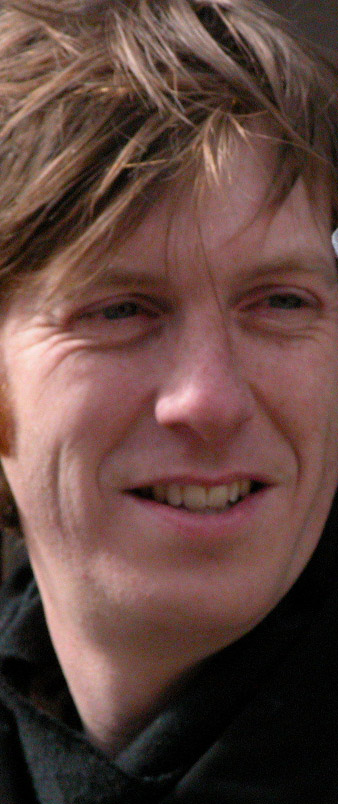Art and Media: Brad Nelson and Allen Fields
A Duluth journalist and musician and the director of the Minnesota Ballet share their views. (This is a reprint of a piece published in December 2002, addressing an issue that's heating up now, as newspapers cut arts writers and coverage dwindles.)


The last of the “Art and Media” series: we asked various artists and media types the same six questions about the relation of media to art practice. Here Brad Nelson, publisher of the Ripsaw News and drummer for the Black-Eyed Snakes, and Allen Fields, director of the Minnesota Ballet, weigh in on the issues. To read the others, click the links at the foot of the article.
BRAD NELSON
Do art and media have responsibilities and obligations to one another? What
are they?
I find that question interesting as someone who is on both sides of that line.
I think the media’s responsibility to art is easiest to define. Mainly, to stay
open, alert and aware–to be on the street. Just because an event only drew 20
people doesn’t necessarily mean it doesn’t merit ink. But covering a Britney
Spears concert is good for mass appeal. I think the media owes true artists
as much ink as they can give them–it’s a moral/ethical imperative. If it seems
like I’m overstating that, consider what rap groups like NWA did to teach Americans
about minority ghettos. I don’t think I even knew about that stuff until the
culture started to gain national exposure, and artists did that.
I hope artists don’t feel like they owe media anything. I mean, certainly it
might be in their best interests to work the media in practical ways, like sending
press releases and good photos, but artists should never kowtow to the media’s
game. Look at the current trend: Rolling Stone says that “rock is back” and
pushes the latest craze. Suddenly every band is produced to sound more like
The Strokes and The Hives. Every band that hasn’t “made it” feels they have
to write and sound like that, too. Everything becomes stagnant. That’s bullshit.
Media likes things to come in packages and trends they can understand. To the
best of their ability, artists should always try to buck that.
Which is more powerful, art or media? Does that balance shift?
Art and media are cautious partners, I think. Artists do need the media to gain
exposure, but they also need to move forward.
Are there examples from your field or career that illustrate how art and media
work in symbiotic or opposing fashion?
“The Seattle Sound” was nothing more than one underground music scene. Sure
there were a lot of bands there, but the media did that scene both a service
and a disservice. They exposed it and made quite a few starts out of one medium-sized
urban area. But Nirvana broke the mold when they first rose to commercial radio,
then they became it. Typically scenes stagnate after that exposure. Look at
how long it took Minneapolis to rebound after the success of the ’80s. I think
people have finally started to let go of that era, but it took over 20 years.
At what point do media and the arts converge?
When we started the Ripsaw we really thought of it as art in and of itself.
We tried to stay on the edge with stunning visuals and text. It’s still like
that, but not to such a great extent. I think any of the zines you see are clearly
art. The lines [between art and media] start to blur with publications like
the Ripsaw. At the other end of the spectrum are daily papers, which aren’t
art.
What is the purpose of art? Of media?
Art has so many purposes–to teach, to entertain, to make people think. Media
really does the same thing, just with a different path.
What’s exciting or encouraging about the current state of media, the arts, and
their roles in everyday life? What’s discouraging or boring about those same
things?
Well, it’s pretty boring to talk about media control and art that’s decimated
the realness and utility of those things, but it’s all true and can’t be said
enough. Corporate control has hurt art and the media as much as politics and
homemade burgers. That’s the sad part. The exciting part is that it still flourishes
in spite of that. In Duluth, the Green Party scored 14 percent in the last presidential
election. Where did people learn about that option? Obviously, people have come
to distrust media and they’re looking beyond that. It’s true in politics and
it’s true in art. There are many, many underground bands and artists that are
thriving–Clear Channel be damned.
ALLEN FIELDS
Do art and media have responsibilities and obligations to one another? What
are they?
Directly art and media have no responsibilities to one another. Indirectly the
media is capable of advancing the arts and by doing so perpetuate them for the community
of which they are a part. The media is news-oriented while the arts are
more soulful. The media reports, the arts invent. A good relationship between
the media and its arts community makes for a better environment.
Which is more powerful, art or media? Does that balance shift?
The arts and media are equally powerful for the moment but not the long term.
Arts have legs while the media often has a larger voice due to the various methods
of getting the information to the public. In the case of live ballet one must
be present to enjoy the art form while media can be picked up anywhere, anytime.
The arts have soul while the media does not.
Are there examples from your field or career that illustrate how art and media
work in symbiotic or opposing fashion?
The presentation of our annual Nutcracker performance marries media and ballet through advertising support and profile. The Duluth News Tribune provides a great service to the ballet and at the same time has visibility as a service
to the arts and its community. A perfect relationship.
What is the purpose of art? Of media?
The purpose of the arts is to create and inspire and deal with any and all representations
of our day, our time. When we look at the past it is the arts and culture that
remains that educate us as to who we were. Like the pyramids in Egypt or the
Mayan culture in Mexico.
The purpose of media is to inform and is most commonly story or news oriented.
Media does not have any staying power whereas the arts remain for generations
to follow.